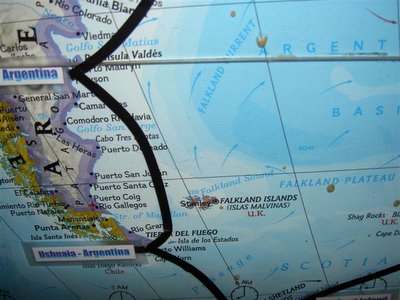
January 31, 2006
Welcome to Puerto Madryn, Argentina
Puerto Madryn is a town in Chubut Province, Patagonia, Argentina. The town was founded on July 28, 1865. 150 Welsh settlers of the ship The Mimosa named the natural port Puerto Madryn after Sir Love Jones Parry, whose title was Madryn Baron. The settlement grew as a result of the railway track laid between Madryn and Trelew built by Welsh, Spanish, and Italian immigrants. Puerto Madryn is protected by the Golfo Nuevo, which is formed by Peninsula Valdos and Punta Ninfas. It is an important town for visiting the natural attractions of the Peninsula Valdos and coast. Occupying the southern part of Argentina is Patagonia, a vast, bleak, and windswept dissected plateau. Several large rivers flow in deep valleys eastward across Patagonia to the sea. Sheep raising (chiefly for wool) and oil and natural gas production (the area around Comodoro Rivadavia is the chief oil-producing region of Argentina) are the principal economic activities of Patagonia. The poor soils of Patagonia and its cool and dry climate do not favor cultivation, although irrigated agriculture is practiced in the Negro and Colorado river valleys. Patagonia is sparsely populated and largely undeveloped, with a few small river-mouth ports on the Atlantic coast such as Viedma, Rawson, Puerto Deseado, and Rio Gallegos.
The People of Argentina
Argentina, unlike most Latin American nations, has a population that is principally of European descent, especially of Italian and Spanish origin. The mestizo portion of Argentina’s population is very small, except in the northwest, because there has been little mixture between European and indigenous peoples. The native population, which has steadily declined since the coming of the Europeans, is still strong only in parts of the Gran Chaco and the Andean highlands. Italian, Spanish, French, German, British, Swiss and East European immigrants came to Argentina during the 1880s; other large immigrations of Europeans occurred in the 1930s and following World War II. The gaucho, or Argentine cowboy, the nomadic herder of the Pampas is still a legendary national symbol. Many gauchos were people of mixed Spanish and African descent who had crossed the border from Brazil to escape slavery. By the 1990s, however, Argentina had a predominantly urban population with about four-fifths of its people living in cities and towns; more than a third of the total population lives in and around Buenos Aires. About 90% of the population is at least nominally Roman Catholic. The Jewish population, while only accounting for about 2% of the people, is the largest in Latin America and the fifth largest in the world. Argentina has one of South America’s lowest population growth rates at only 1.1% but it does have one of its highest literacy rates at 96%.

0 Comments:
Post a Comment
<< Home